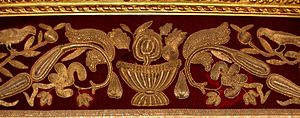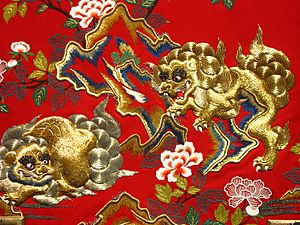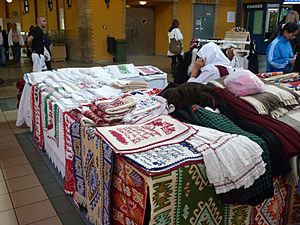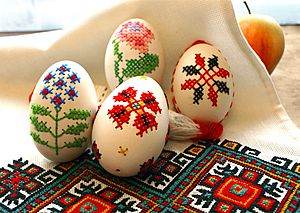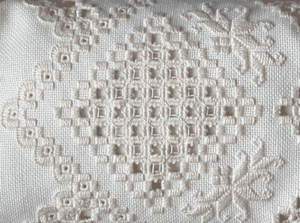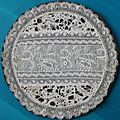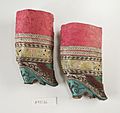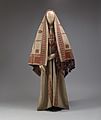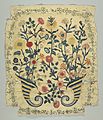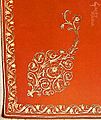Embroidery facts for kids
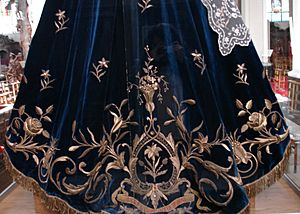
Embroidery is the art of decorating fabric. You use a needle and thread to create amazing designs. Sometimes, other cool materials like pearls, beads, or sequins are added too! You can even use special sewing machines to make machine embroidery.
Contents
History of Embroidery
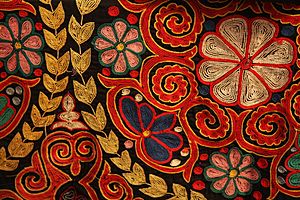
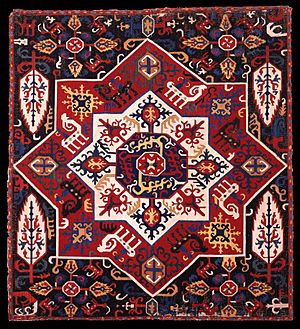
Where Did Embroidery Start?
People have been sewing for a very long time. They used stitches to fix clothes or make them stronger. Over time, they realized they could also make beautiful designs with these stitches. That's how embroidery began!
It's amazing how old embroidery is. The basic stitches used today are very similar to those used thousands of years ago. Experts say that early embroidery was often very detailed and well-made.
Embroidery has been found all over the world. In China, some designs are from the Warring States period (around 5th to 3rd century BC). Ancient Greek mythology even says that the goddess Athena taught people how to embroider and weave.
How Was Embroidery Used?
Embroidery has been used in many different ways throughout history. It depended on the time, place, and what materials people had.
Fancy embroidered clothes and items often showed that someone was rich or important. For example, in medieval England, a special technique called Opus Anglicanum was used. Professional artists made these amazing pieces. In the 1700s, rich girls in England learned embroidery. It was a skill that showed they were growing up and had a good social standing.
But embroidery was also a popular art for everyone. People used materials they could easily find. Examples include Hardanger from Norway and Sashiko from Japan. Sashiko was even used to make clothes stronger, showing it had a practical use too!
Embroidery in the Islamic World
Embroidery was a very important art in the medieval Islamic world. A traveler from Turkey in the 1600s called it the "craft of the two hands." It was a sign of high social status, so it became very popular.
In cities like Damascus, Cairo, and Istanbul, you could see embroidery everywhere. It was on handkerchiefs, uniforms, flags, shoes, robes, and even horse decorations. Artists used gold and silver thread to make these items shine. Many small businesses grew, with hundreds of people working to create these embroidered goods.
In the 1500s, during the time of the Mughal Emperor Akbar, a writer named Abu al-Fazl ibn Mubarak wrote about how much Akbar loved embroidered fabrics. He mentioned that workshops in cities like Lahore and Agra made many masterpieces.
Machines and Embroidery
The way embroidery was made changed a lot during the Industrial Revolution. Machines started to take over some of the work. At first, machines helped with weaving, and then women would embroider by hand. This happened in France in the mid-1800s. Later, machine-made embroidery became very popular in places like St. Gallen in Switzerland.
Types of Embroidery
Embroidery can be grouped into different types based on how the stitches are placed on the fabric. The main types are free or surface embroidery, counted embroidery, and needlepoint.
In free or surface embroidery, you stitch designs onto the fabric without worrying about its weave. Think of it like drawing on a blank canvas with thread. Examples include crewel and traditional Chinese and Japanese embroidery.
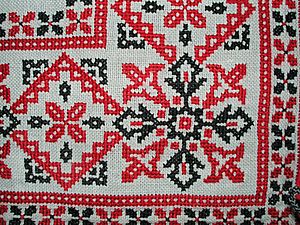
Counted-thread embroidery uses patterns where you count the threads of the fabric to place your stitches. This type works best on fabrics with an even weave, like aida cloth. Cross-stitch is a very popular example of counted-thread embroidery.
Needlepoint (also called canvas work) is similar to counted-thread, but you stitch through a mesh fabric. The stitches are so close together that they completely cover the fabric underneath. Bargello is a type of needlepoint.
Some embroidery styles change the fabric itself. In drawn thread work and cutwork, parts of the fabric are pulled out or cut away. Then, these holes are decorated with more stitches. When this is done with white thread on white fabric, it's called whitework. Hardanger embroidery is a type of whitework that uses counted stitches to make geometric designs.
Materials for Embroidery
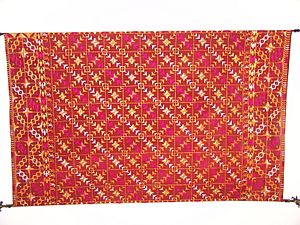
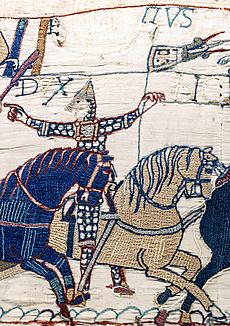
The fabrics and threads used in embroidery change depending on where you are in the world. For thousands of years, people have used wool, linen, and silk for both the fabric and the thread.
Today, you can find embroidery thread made from cotton, rayon, and other fun yarns. Ribbon embroidery uses thin ribbons, often made of silk, to create beautiful flower designs.
Some techniques, like chain stitch, use less thread. Other techniques, like needlepoint, use a lot more thread because it's hidden on the back of the work. But these methods make the finished piece very strong.
When you embroider, you might use an embroidery hoop or frame. This stretches the fabric tightly, which helps you make even stitches and keeps your design from getting distorted.
Machine Embroidery Today
Today, a lot of embroidery is done with special computerized machines. These machines use digital patterns to create designs. They can add different textures and looks to the finished work.
Machine embroidery is often used to add logos or monograms to shirts, jackets, or team uniforms. It's also used to decorate home items like curtains. These machines can even create designs that look like the fancy hand embroidery of the past.
There are also new machines that let artists create "free-hand" machine embroidery. This is used in textile art, quilting, and making clothes.
Learning Embroidery Skills
If you love embroidery, you can even get special qualifications to show how skilled you are! These qualifications can help you become a recognized artist or even teach others how to embroider. For example, a famous textile artist named Kathleen Laurel Sage got these qualifications before writing a book about embroidery.
Gallery
-
English cope, late 15th or early 16th century. Silk velvet embroidered with silk and gold threads, closely laid and couched. Contemporary Art Institute of Chicago textile collection.
-
Bookmark of black fabric with multicolored Bedouin embroidery and tassel of embroidery floss
Images for kids
-
Embroidered book cover made by Elizabeth I at the age of 11, presented to Katherine Parr
-
19th century women's thobe from Ramallah
-
Gold embroidery on a gognots (apron) of a 19th-century Armenian bridal dress from Akhaltsikhe
See also
 In Spanish: Bordado para niños
In Spanish: Bordado para niños


